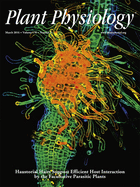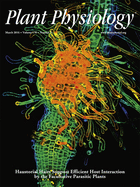
Cover image

On the Cover: Parasitic plants form a specialized organ, the haustorium, to penetrate the host and obtain nutrition. At initiation, hairs proliferate on the surface of the haustorium. These hairs resemble root hairs and are widely observed on the roots of parasitic plants, including economically important parasitic family Orobanchaceae. In pp. 1492–1503, Cui et al. performed a forward genetic screen in the facultative parasitic plant Phtheirospermum japonicum to identify mutants with altered haustorial morphologies. They identified three mutants that are defective in formation of haustorial hairs. Characterization of these mutants shows that haustorial hairs are controlled by the root hair developmental program and support parasitism through tight interactions with host plant roots. The cover shows a fluorescent image of P. japonicum haustorial hairs covering the surface of a haustorium, which is induced by a host-derived chemical 2,6-dimethoxy-p-benzoquinone (DMBQ). Cover image credits: S. Cui, S. Yoshida and K. Shirasu (RIKEN Center for Sustainable Resource Science, Yokohama, Japan).
Volume 170, Issue 3, March 2016
ON THE INSIDE
On the Inside
EDITORIAL
When Is Science ‘Ultimately Unreliable’?
COMMENTARY
Trichome Formation: Gibberellins on the Move
BREAKTHROUGH TECHNOLOGIES
Quantitative 3D Analysis of Plant Roots Growing in Soil Using Magnetic Resonance Imaging
Magnetic resonance imaging (MRI) enables nondestructive 3D imaging and quantification of roots or root system architecture in soil and is suited for automated and routine measurements of root development.
Affinity Purification and Characterization of Functional Tubulin from Cell Suspension Cultures of Arabidopsis and Tobacco
New methods allow for efficient affinity purification of polymerization-competent tubulin from tobacco and Arabidopsis cell cultures.
UPDATE
SIGNALING AND RESPONSE
Auxin and Cellular Elongation
Multiple modes of auxin action are integrated as a crucial growth regulator in the single cell model of the root hair.
Articles
BIOCHEMISTRY AND METABOLISM
PSR1 Is a Global Transcriptional Regulator of Phosphorus Deficiency Responses and Carbon Storage Metabolism in Chlamydomonas reinhardtii
A transcription factor induced by phosphate starvation regulates metabolism genes to enhance starch biosynthesis in microalgae.
Grapevine Plasticity in Response to an Altered Microclimate: Sauvignon Blanc Modulates Specific Metabolites in Response to Increased Berry Exposure
Grapevine responds to increased exposure in the bunch zone by up-regulating photoprotective carotenoids in the early developmental stages and volatile terpenoids in the later ripening stages of the berries in a proposed mechanism of antioxidant homeostasis maintenance.
Deficiency of Starch Synthase IIIa and IVb Alters Starch Granule Morphology from Polyhedral to Spherical in Rice Endosperm
Deficiency of starch synthases IIIa and IVb, which elongate the long chains of amylopectin, drastically changes starch granule morphology from polyhedral to spherical in rice endosperm.
Analysis of the Rice ADP-Glucose Transporter (OsBT1) Indicates the Presence of Regulatory Processes in the Amyloplast Stroma That Control ADP-Glucose Flux into Starch
Rice lines with enhanced ADPglc synthesis and import into amyloplasts reveal additional barriers within the stroma that restrict maximum carbon flow into starch.
Glutaredoxin S15 Is Involved in Fe-S Cluster Transfer in Mitochondria Influencing Lipoic Acid-Dependent Enzymes, Plant Growth, and Arsenic Tolerance in Arabidopsis
The Fe-S binding monothiol GrxS15 is localized to mitochondria; its absence slows growth and respiration and increases arsenic susceptibility.
ALA10, a Phospholipid Flippase, Controls FAD2/FAD3 Desaturation of Phosphatidylcholine in the ER and Affects Chloroplast Lipid Composition in Arabidopsis thaliana
The ALA10 phospholipid flippase reduces phosphatidylcholine desaturation and stimulates galactolipid-tophosphatidylcholine ratio in photosynthetic tissues.
MdMYB1 Regulates Anthocyanin and Malate Accumulation by Directly Facilitating Their Transport into Vacuoles in Apples
An MYB transcription factor influences organ coloration and acidity by activating the expression of the genes encoding vacuolar proton pump subunits as well as anthocyanin transporters and malate transporters.
Acylsugar Acylhydrolases: Carboxylesterase-Catalyzed Hydrolysis of Acylsugars in Tomato Trichomes
Acylsugar acylhydrolases are carboxylesterases that catalyze the hydrolysis of specific acyl chains from acylsugars found in trichomes.
A Specific Transcriptome Signature for Guard Cells from the C4 Plant Gynandropsis gynandra
Transcript profiling from closely related C3 and C4 species identifies a core guard cell signature as well as two patterns of gene expression associated with C4 photosynthesis across the C4 leaf.
Structural Redesigning Arabidopsis Lignins into Alkali-Soluble Lignins through the Expression of p-Coumaroyl-CoA:Monolignol Transferase PMT
Arabidopsis lignins, which are genetically p-coumaroylated up to the grass lignin level, display dramatic structural changes that make them more amenable to solubilization in alkali at room temperature.
Xyloglucan Metabolism Differentially Impacts the Cell Wall Characteristics of the Endosperm and Embryo during Arabidopsis Seed Germination
During germination, defective xylose trimming alters xyloglucan anisotropic localization in cell walls during hypocotyl elongation and decreases endosperm resistance to radicle protrusion
CELL BIOLOGY
TOPP4 Regulates the Stability of PHYTOCHROME INTERACTING FACTOR5 during Photomorphogenesis in Arabidopsis
A type 1 protein phosphatase, TOPP4, participates in the phyB signaling pathway by dephosphorylating PIF5 and controlling the stability of PIF5 in seedlings.
Functional Analysis of Cellulose and Xyloglucan in the Walls of Stomatal Guard Cells of Arabidopsis
Sufficient cellulose and xyloglucan production controls proper guard cell expansion and allows for cellulose reorganization as stomata open or close.
Nuclear Function of Subclass I Actin-Depolymerizing Factor Contributes to Susceptibility in Arabidopsis to an Adapted Powdery Mildew Fungus
The nuclear localization of subclass I actin-depolymerizing factor is critical for the susceptibility against an adapted powdery mildew.
Enhanced Stomatal Conductance by a Spontaneous Arabidopsis Tetraploid, Me-0, Results from Increased Stomatal Size and Greater Stomatal Aperture
The Arabidopsis tetraploid ecotype, Me-0, overcomes the handicap of stomatal opening that is typical for tetraploid plants and achieves a high stomatal conductance.
Amyloplast Membrane Protein SUBSTANDARD STARCH GRAIN6 Controls Starch Grain Size in Rice Endosperm
Starch grain size is an important factor for industrial applications of starch and is affected by a novel amyloplast membrane protein.
ECOPHYSIOLOGY AND SUSTAINABILITY
Water Deficit Enhances C Export to the Roots in Arabidopsis thaliana Plants with Contribution of Sucrose Transporters in Both Shoot and Roots
Mild water deficit enhances C export to the roots and modifies root architecture, with a subset of sucrose transporters involved in both shoot and roots.
Climate and Developmental Plasticity: Interannual Variability in Grapevine Leaf Morphology
Changes in climate alter specific shape features of grapevine leaves, regardless of evolutionary or developmental context.
GENES, DEVELOPMENT AND EVOLUTION
Haustorial Hairs Are Specialized Root Hairs That Support Parasitism in the Facultative Parasitic Plant Phtheirospermum japonicum
Isolation and analysis of parasitic plant mutants with defects in haustorial hair development shows that these specialized root hairs are important for tight interactions with the host plant roots.
Response of Organ Structure and Physiology to Autotetraploidization in Early Development of Energy Willow Salix viminalis
Enlarged leaf size, stem diameter, and root system of autotetraploid energy willows are associated with changes in hormonal status and the efficiency of photosynthesis.
Cis-Regulatory Elements Determine Germline Specificity and Expression Level of an Isopentenyltransferase Gene in Sperm Cells of Arabidopsis
A regulatory region consisting of duplicated motifs activates gene expression in plant male gamete.
Genome-Wide Characterization of Maize Small RNA Loci and Their Regulation in the required to maintain repression6-1 (rmr6-1) Mutant and Long-Term Abiotic Stresses
Agronomically realistic, long-term drought stress mis-regulates some miRNAs and induces the down-regulation of a set of small RNA loci in the maize leaf.
The Dynamics of Transcript Abundance during Cellularization of Developing Barley Endosperm
Gene transcript profiles during barley endosperm cellularization reveal functional modules, coexpression networks, and regulatory genes, all of which align with cell wall changes in developing grain.
H3K36ac Is an Evolutionary Conserved Plant Histone Modification That Marks Active Genes
Profiling of histone H3 modifications by MS/MS identified the H3K36ac histone modification, which is introduced at the first 500 bp of active Arabidopsis genes and is conserved in gymnosperms and angiosperms.
The tae-miR408-Mediated Control of TaTOC1 Genes Transcription Is Required for the Regulation of Heading Time in Wheat
A wheat microRNA promotes heading by negatively regulating expression of homologs of the clock gene TOC1.
Evolutionary Dynamics of the Leucine-Rich Repeat Receptor-Like Kinase (LRR-RLK) Subfamily in Angiosperms
Phylogenetic analysis of leucine-rich repeat-containing receptor-like kinases demonstrates the dynamic nature of gene duplication, loss, and selection in this family.
Defective Tapetum Cell Death 1 (DTC1) Regulates ROS Levels by Binding to Metallothionein during Tapetum Degeneration
Timely production of superoxides is essential for initiation of tapetum degeneration in rice.
TEMPRANILLO Reveals the Mesophyll as Crucial for Epidermal Trichome Formation
Tonoplast Aquaporins Facilitate Lateral Root Emergence
Aquaporins located in the vacuolar membrane contribute to the proper development of lateral roots.
Combined Chlorophyll Fluorescence and Transcriptomic Analysis Identifies the P3/P4 Transition as a Key Stage in Rice Leaf Photosynthetic Development
A combined transcriptomic and physiological analysis of rice leaf development identifies the stage (P3/P4 transition) when photosynthetic competence is first established.
SEUSS Integrates Gibberellin Signaling with Transcriptional Inputs from the SHR-SCR-SCL3 Module to Regulate Middle Cortex Formation in the Arabidopsis Root
The transcription factor SEU promotes middle cortex formation through a network of transcription factor interactions.
MEMBRANES, TRANSPORT AND BIOENERGETICS
Nitrogen Use Efficiency Is Mediated by Vacuolar Nitrate Sequestration Capacity in Roots of Brassica napus
Nitrogen use efficiency is mediated by vacuolar nitrate sequestration capacity in roots
SIGNALING AND RESPONSE
Arabidopsis HY1-Modulated Stomatal Movement: An Integrative Hub Is Functionally Associated with ABI4 in Dehydration-Induced ABA Responsiveness
The heme oxygenase HY1 functions negatively and acts upstream in drought-induced ABA signaling, and this cascade depends on RbohD-derived ROS production in the regulation of stomatal closure.
Phosphatidylinositol 3-Kinase Promotes Activation and Vacuolar Acidification and Delays Methyl Jasmonate-Induced Leaf Senescence
Phosphatidylinositol 3-kinase promotes proton pump activation, resulting in vacuolar acidification and stomatal closing, thereby delaying methyl jasmonate-induced leaf senescence.
Comprehensive Profiling of Ethylene Response Factor Expression Identifies Ripening-Associated ERF Genes and Their Link to Key Regulators of Fruit Ripening in Tomato
A small subset of ethylene response factor genes emerge as main actors in controlling fruit ripening via both ethylene-dependent and RIN/NOR-mediated mechanisms.
Chloroplast Activity and 3′phosphadenosine 5′phosphate Signaling Regulate Programmed Cell Death in Arabidopsis
Chloroplasts modulate programmed cell death via at least two different pathways: photosynthetic activity is required for cell death while a retrograde signal negatively regulates cell death and plant innate immunity.
Singlet Oxygen-Induced Cell Death in Arabidopsis under High-Light Stress Is Controlled by OXI1 Kinase
The AGC kinase OXI1 regulates 1O2-induced cell death in plants exposed to excess light energy.
Light-Inducible MiR163 Targets PXMT1 Transcripts to Promote Seed Germination and Primary Root Elongation in Arabidopsis
MiR163 targets PXMT1 transcripts at the early stage of light responses to promote seed germination and root development.
Root Type-Specific Reprogramming of Maize Pericycle Transcriptomes by Local High Nitrate Results in Disparate Lateral Root Branching Patterns
Root type-specific lateral root branching and pericycle-specific transcriptome reprogramming highlight diverse foraging strategies of maize roots in heterogeneous nitrate environments.
The Wheat Mediator Subunit TaMED25 Interacts with the Transcription Factor TaEIL1 to Negatively Regulate Disease Resistance against Powdery Mildew
A conserved Mediator complex subunit physically interacts with the transcription factor ETHYLENE INSENSITIVE3-LIKE1 (TaEIL1) to promote ETHYLENE RESPONSE FACTOR1 (TaERF1) expression and repress powdery mildew resistance.
GUN1 Controls Accumulation of the Plastid Ribosomal Protein S1 at the Protein Level and Interacts with Proteins Involved in Plastid Protein Homeostasis
The gene product associated with a so-called Genomes UNcoupled (gun) mutant interacts with proteins involved in plastid protein homeostasis.
The DELLA Protein SLR1 Integrates and Amplifies Salicylic Acid- and Jasmonic Acid-Dependent Innate Immunity in Rice
A growth-inhibiting protein boosts the action of the defense-related plant hormones salicylic acid and jasmonic acid, rendering rice plants more resistant to pathogen attack.
SYSTEMS AND SYNTHETIC BIOLOGY
Combined Large-Scale Phenotyping and Transcriptomics in Maize Reveals a Robust Growth Regulatory Network
Combining in-depth phenotyping with transcript profiling in maize recombinant inbred lines untangles the genetic control of complex traits.
Production and Characterization of Synthetic Carboxysome Shells with Incorporated Luminal Proteins
Synthetic carboxysome shells, containing all of the key component proteins provide a platform for fundamental studies of shell permeability and metabolic modeling of organelle function.
FamNet: A Framework to Identify Multiplied Modules Driving Pathway Expansion in Plants
Gene module multiplication drives pathway expansion in plants.


